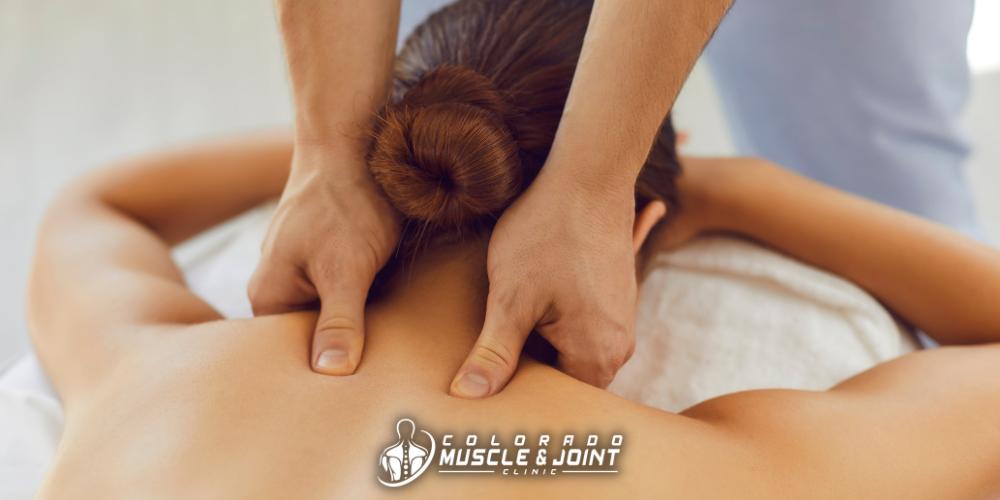Myofascial Release
Myofascial Release in Loveland, CO
Myofascial trigger point therapy is a common type of massage therapy offered by holistic practitioners such as chiropractors, physical therapists, massage therapists, and occupational therapists. It’s designed to provide relief to people who are experiencing pain within their myofascial system. Additionally, myofascial release therapy can improve mobility, range of motion, circulation, and feelings of chronic stress. Below, Dr. Huebner explains the specifics of myofascial release therapy: what it is, what it treats, how it works, and whether or not you would be a good candidate for this treatment.
Call 970-744-6499 to schedule an appointment at the Colorado Muscle & Joint Clinic today.

What is Myofascial Release?
Myofascial release therapy (also known as trigger point therapy) is a type of manual therapy that’s designed to relieve pain from the myofascial tissues in the body. Let’s break the word down. “Myo” means muscle, and “fascial” means connective tissues.
Many holistic practitioners – such as physical therapists, massage therapists, and chiropractors – believe that certain types of musculoskeletal pain originate from specific “trigger points.” Trigger points can feel like lumps or knots in the muscles. So the goal is to locate the trigger points within the myofascial tissues and apply pressure until the tension releases or the pain disappears.
What is Fascia?
Understanding the fascia is an important part of understanding myofascial release therapy as a whole.
In simple terms: fascia is a huge web of connective tissue that extends throughout the entire body. Fascia connects everything and keeps it all together: the muscles, organs, bones, tendons, ligaments, joints, nerves, etc. Without connective tissues like fascia, you wouldn’t be able to move or stretch without suffering friction between the muscles as they slide next to each other. You also wouldn’t be able to stabilize and move your own joints. Most importantly – all of the systems in your body would struggle to work together without fascia.
Myofascial tissue is thin, but incredibly strong and flexible. It’s mostly made up of collagen and hyaluronan. Traumatic accidents and inflammation can cause serious damage to the hyaluronan and the fascia as a whole. Injured, inflamed, and tight fascia can lead to mobility issues and chronic pain throughout the body.
What is Myofascial Pain Syndrome?
Myofascial pain syndrome is a chronic pain disorder caused by muscle strain or injury, poor posture, pinched nerves, or psychological stress. Sometimes this condition is confused or misdiagnosed with fibromyalgia because they share similar symptoms. But these are two different disorders.
According to the Cleveland Clinic, 85% of people can experience myofascial pain syndrome at some point in their lives. The main symptom is just constant pain and tightness within the muscles. The pain can feel throbbing, stiff, aching, or tight. Many patients with this disorder also suffer from muscle weakness, knots in the muscles, and reduced mobility and range of motion.
Myofascial pain syndrome most commonly affects these muscles:
- Trapezius: A triangle shaped muscle in the back that allows you to turn your head and neck, shrug your shoulders, and move your arms.
- Sternocleidomastoid: The two long muscles on either side of the neck that extend from the bottom of the ear to the clavicle bones. These muscles also allow you to turn your head and flex your neck.
- Infraspinatus: The two muscles that extend across each shoulder blade. This set of muscles is one of four that surround the rotator cuff. It allows you to move and stabilize your shoulders.
- Levator Scapulae: A set of two muscles that extend from the bottom of the head to the top of the shoulder blades. These muscles allow you to rotate the shoulder blades.
- Rhomboids: This set of muscles extends from the upper lumbar spine to the shoulder blades. They are responsible for attaching your arms to your shoulder blades and pulling the shoulder blades together.
How Myofascial Release Works
Your chiropractor, physical therapist, or massage therapist will start by asking where your pain is and what it feels like. They will also perform a physical exam to find the trigger points in your myofascial system. Next, your provider will apply pressure to specific points of tight tissue throughout the body. Sustained pressure, kneading, and stretching of stiff areas can help to relieve chronic pain.
There are many myofascial release techniques used in physical therapy, including:
- Instrument Assisted Soft Tissue Mobilization (IASTM) is basically massage therapy using special instruments (pictured below) instead of using hands.
- Foam Rolling is a common self-myofascial release technique where you roll out your muscles on a cylinder of foam. A chiropractor, massage therapist, or physical therapist can also use a foam roller massager on their patients with myofascial pain.
- Pin and Stretch: This myofascial release technique is characterized by a physical therapist “pinning” some soft tissue in place with their hands, arm, or elbow while simultaneously stretching out the soft tissue.
- Post Isometric Relaxation Stretching involves stretching, contracting, and then relaxing muscles that may be causing pain.
- Band Flossing involves wrapping a latex band around tight and painful muscles while doing specific exercises to improve range of motion.

What Can Myofascial Release Treat?
Myofascial release therapy can treat myofascial pain syndrome and other health conditions such as:
- Carpal tunnel syndrome
- Chronic migraines
- Temporomandibular joint (TMJ) disorder
- Neck and back pain
- Fibromyalgia
- Aches and pains during pregnancy
- Sciatica
- Muscular sprains and strains
Benefits of Myofascial Release
Myofascial release therapy comes with a wide variety of health benefits, most notably:
- Musculoskeletal pain relief
- Improved mobility and range of motion
- Less frequent or less severe headaches
- Less physical and psychological stress
- Accelerated healing from sports injuries
- Improved circulation
Who is a Good Candidate for Myofascial Release?
Myofascial release therapy can benefit anyone who experiences widespread pain and tightness throughout the body, inflammation, scarring from past physical trauma, pinched nerves, and headaches.
On the other hand, if you’re currently experiencing the following physical issues, you should avoid myofascial release therapy for the time being.
- Broken bones
- Extensive burns
- Open wounds
- Health conditions that require you to take blood thinners
- Blood clots in deep veins (deep vein thrombosis)


